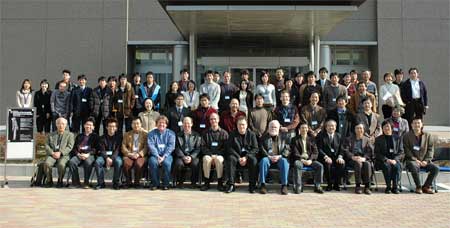| RIKEN Center for
Developmental Biology (CDB) 2-2-3 Minatojima minamimachi, Chuo-ku, Kobe 650-0047, Japan |
| CDB Meeting: Diversity of Developmental Mechanisms in Invertebrates | ||
February 3, 2005 – The RIKEN Center for Developmental Biology hosted a two-day meeting on the diversity of development and pattern formation processes in arthropods and other invertebrates.Speakers included a number of distinguished scientists working with a wide range of invertebrate systems, and the meeting served as a forum for the active and open exchange of ideas and stimulus to further research into this largely unexplored set of models. Yoshiko Inoue, of the Laboratory for Morphogenetic Signaling (Shigeo Hayashi, Group Director) reported on the event.
“The meeting was held on February 2 and 3, which it turned out were some of the coldest days of the winter so far. Kobe has a fairly temperate climate, but the low temperature on the 2nd was below freezing, and although there were some public transportation delays, the turnout was quite high. Despite the cold outside, the first day heated up with talks by some of the most prominent researchers in arthropod morphogenesis from institutes around Japan. Taking a cue from Thomas Kaufman’s closing talk on the first day of the meeting, speakers on day two presented work on body segmentation, providing what may have been the most comprehensive treatment of the diversity of segmentation processes seen in Japan to date. Drosophila research has given us a well-established body of work providing insight into the segmentation of the invertebrate body, but studies of gap genes, the pair rule and segment polarity in other invertebrate taxa show that the patterns of expression and function of the genes involved differ from species to species. It was striking, for example, to see how diverse the expression of the pair-rule transcription factor even-skipped is, even between insect species, making me wonder whether such variation might be an effect of changes in the functional levels of proteins. The debate over possible homologies between body segmentation in vertebrates and that in spider, centipede, leech and short-germ insects was also keen, and though more work will need to be done before the picture is clearly resolved, I felt that the chance for so many people in the field to get together for face-to-face discussions made a contribution toward the development of at least some consensus. The late 1990s saw the introduction of RNAi methods, particularly parental RNAi, capable of knocking down gene expression in non-standard invertebrate models, and the application of these tools has now made it possible to take the study of many species to new levels of depth and detail and opened up new horizons for scientists to explore. One of the merits of holding this CDB Meeting was that it allowed people working in this rapidly evolving field to get an overview of and discuss recent trends and research developments – in fact the meeting itself coalesced with remarkable speed, organized in only four short months. The meeting was significant for more than just its scientific content, in that it brought together scientists, including many students, from within RIKEN and across Japan. Bringing the latest generations of researchers together in a meeting such as this can serve as a stimulus for the growth of a field, something I think we can look forward to here, as the domestic venue made it possible for young Japanese scientists, who might have had difficulty going to a conference held overseas, to attend. It’s wonderful that the CDB was able to provide this generation of researchers the opportunity to participate in this type of international scientific exchange, and I hope that we’ll have chances to continue to support more such evo-devo meetings in the future.”
|
||
|
||
[ Contact ] Douglas Sipp : sipp@cdb.riken.jp TEL : +81-78-306-3043 RIKEN CDB, Office for Science Communications and International Affairs |
| Copyright (C) CENTER FOR DEVELOPMENTAL BIOLOGY All rights reserved. |
